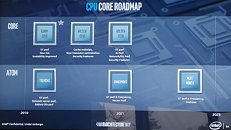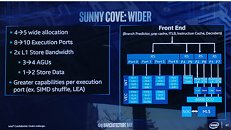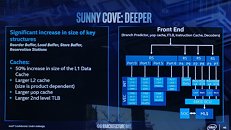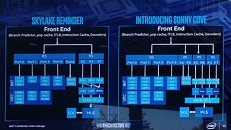Wednesday, December 12th 2018

Intel Unveils a Clean-slate CPU Core Architecture Codenamed "Sunny Cove"
Intel today unveiled its first clean-slate CPU core micro-architecture since "Nehalem," codenamed "Sunny Cove." Over the past decade, the 9-odd generations of Core processors were based on incrementally refined descendants of "Nehalem," running all the way down to "Coffee Lake." Intel now wants a clean-slate core design, much like AMD "Zen" is a clean-slate compared to "Stars" or to a large extent even "Bulldozer." This allows Intel to introduce significant gains in IPC (single-thread performance) over the current generation. Intel's IPC growth curve over the past three micro-architectures has remained flat, and only grew single-digit percentages over the generations prior.
It's important to note here, that "Sunny Cove" is the codename for the core design. Intel's earlier codenaming was all-encompassing, covering not just cores, but also uncore, and entire dies. It's up to Intel's future chip-designers to design dies with many of these cores, a future-generation iGPU such as Gen11, and a next-generation uncore that probably integrates PCIe gen 4.0 and DDR5 memory. Intel details "Sunny Cove" as far as mentioning IPC gains, a new ISA (new instruction sets and hardware capabilities, including AVX-512), and improved scalability (ability to increase core-counts without running into latency problems).The first products featuring "Sunny Cove" cores is slated as early as by 2019, and will be built on Intel's 10 nm DUV silicon fabrication process. Intel didn't stop at "Sunny Cove," and went on to mention two of its successors. "Willow Cove" is an incremental update, letting its designers eke out more effective IPC by improving on-die caches, transistor optimization, and the addition of new security features. In many ways, "Sunnycove" and "Willow Cove" relate to each other like AMD's "Zen" and "Zen+." The first "Willow Cove" based processors will launch in 2020, based on a refined 10 nm process node.Lastly there's "Golden Cove," slated for 2021. Here Intel could take advantage of a newer silicon fabrication process (either an extremely refined 10 nm-derivative or even 7 nm EUV), to increase IPC (single-thread performance). In addition, Intel will improve the core's "AI performance" (probably the ability to multiply matrices), and improved host-signal processing for 5G and networking.
Intel's low-power architectures see "Tremont" succeed "Goldmont" in 2019, packing increased IPC, battery management, and network HSP. "Gracemont," slated for 2021, will improve IPC further, and improve "Vector performance," possibly heralding AVX in some form to the low-power architecture. Gracemont is succeeded by "next" mont (Intel hasn't decided a codename yet) in 2022+, with even higher IPC.
Source:
Anandtech
It's important to note here, that "Sunny Cove" is the codename for the core design. Intel's earlier codenaming was all-encompassing, covering not just cores, but also uncore, and entire dies. It's up to Intel's future chip-designers to design dies with many of these cores, a future-generation iGPU such as Gen11, and a next-generation uncore that probably integrates PCIe gen 4.0 and DDR5 memory. Intel details "Sunny Cove" as far as mentioning IPC gains, a new ISA (new instruction sets and hardware capabilities, including AVX-512), and improved scalability (ability to increase core-counts without running into latency problems).The first products featuring "Sunny Cove" cores is slated as early as by 2019, and will be built on Intel's 10 nm DUV silicon fabrication process. Intel didn't stop at "Sunny Cove," and went on to mention two of its successors. "Willow Cove" is an incremental update, letting its designers eke out more effective IPC by improving on-die caches, transistor optimization, and the addition of new security features. In many ways, "Sunnycove" and "Willow Cove" relate to each other like AMD's "Zen" and "Zen+." The first "Willow Cove" based processors will launch in 2020, based on a refined 10 nm process node.Lastly there's "Golden Cove," slated for 2021. Here Intel could take advantage of a newer silicon fabrication process (either an extremely refined 10 nm-derivative or even 7 nm EUV), to increase IPC (single-thread performance). In addition, Intel will improve the core's "AI performance" (probably the ability to multiply matrices), and improved host-signal processing for 5G and networking.
Intel's low-power architectures see "Tremont" succeed "Goldmont" in 2019, packing increased IPC, battery management, and network HSP. "Gracemont," slated for 2021, will improve IPC further, and improve "Vector performance," possibly heralding AVX in some form to the low-power architecture. Gracemont is succeeded by "next" mont (Intel hasn't decided a codename yet) in 2022+, with even higher IPC.





57 Comments on Intel Unveils a Clean-slate CPU Core Architecture Codenamed "Sunny Cove"
Your mom and grandfather would have had a much shittier experience browsing the web without multiple cores on their device of choice because even browsers are multithreaded these days.
I even said hardware mfg are CREATING a need just by the products existing (kind of how it works if there isn't an actual need). I get that hardware needs to be out for it to succeed and take hold in the market (though oddly, this argument doesn't hold true for RTX to some, lol). But there just isn't a need for it on the user side.... which is my whooooooooooooooooooooooooole point.
My mom and grandma do just fine on quad cores...nobody is talking about annnnnnnnnnnnything less... not sure what your point is there.
Good talk. :)
Greetings
Your chief mistake seems to be to conflate an inferior design and its resulting lower performance with symmetric multithreading. It was a bad argument when people made it back in 2011 and it's a worse argument now that there has been so much time during which to learn from that mistake.